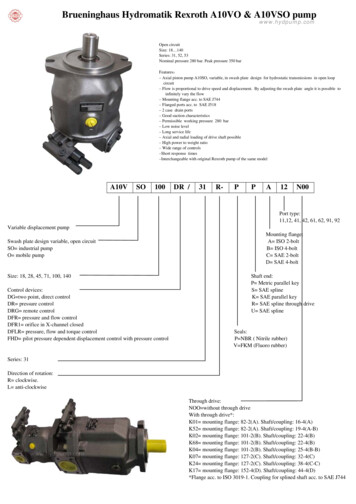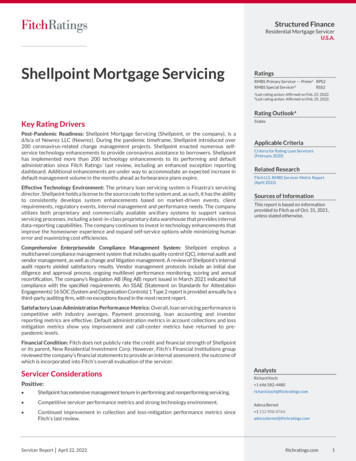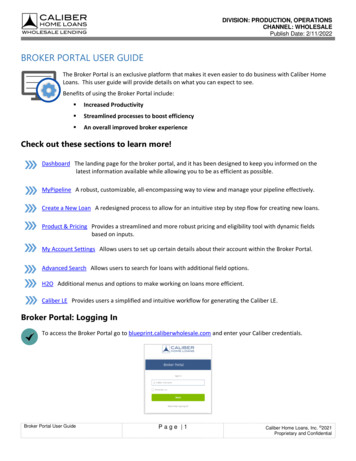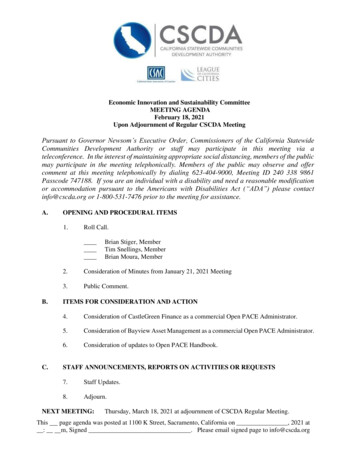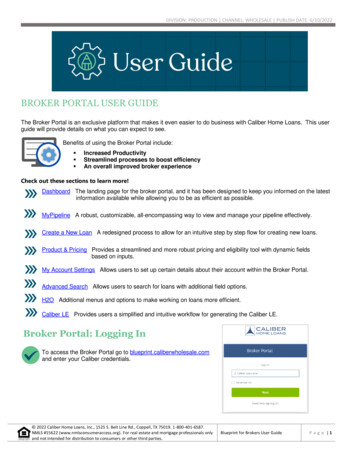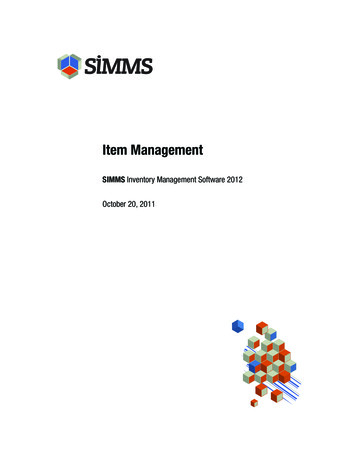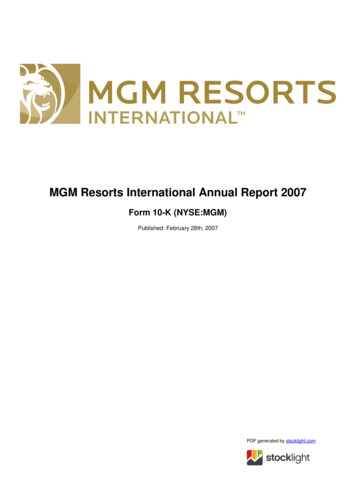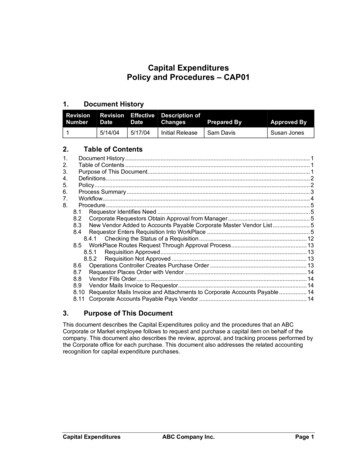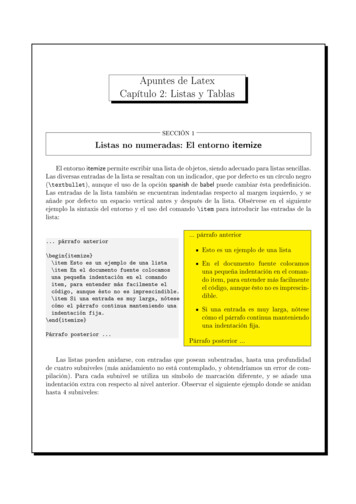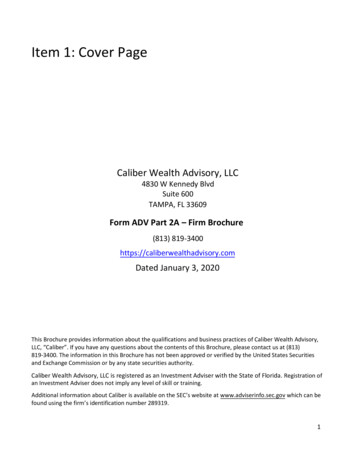
Transcription
Item 1: Cover PageCaliber Wealth Advisory, LLC4830 W Kennedy BlvdSuite 600TAMPA, FL 33609Form ADV Part 2A – Firm Brochure(813) 819-3400https://caliberwealthadvisory.comDated January 3, 2020This Brochure provides information about the qualifications and business practices of Caliber Wealth Advisory,LLC, “Caliber”. If you have any questions about the contents of this Brochure, please contact us at (813)819-3400. The information in this Brochure has not been approved or verified by the United States Securitiesand Exchange Commission or by any state securities authority.Caliber Wealth Advisory, LLC is registered as an Investment Adviser with the State of Florida. Registration ofan Investment Adviser does not imply any level of skill or training.Additional information about Caliber is available on the SEC’s website at www.adviserinfo.sec.gov which can befound using the firm’s identification number 289319.1
Item 2: Material ChangesThe last annual update of this brochure was filed on January 1, 2019. The following changes have beenmade to this version of the Disclosure Brochure:Item 1: New physical address and phone number added.Item 4: Added Schwab Institutional Intelligent Portfolios (SIIP) as an outside tradingmanager.Item 5: Updated fee structure for Retirement Plan Consulting and Schwab’s InstitutionalIntelligent Portfolios(SIIP).Item 8: Review process for the Use of Outside Trading Managers.Item 12: Added Charles Schwab as a custodian for client accounts.Future ChangesFrom time to time, we may amend this Disclosure Brochure to reflect changes in our business practices,changes in regulations and routine annual updates as required by the securities regulators. This completeDisclosure Brochure or a Summary of Material Changes shall be provided to each Client annually and if amaterial change occurs in the business practices of Caliber.At any time, you may view the current Disclosure Brochure on-line at the SEC’s Investment Adviser PublicDisclosure website at http://www.adviserinfo.sec.gov by searching for our firm name or by our CRDnumber 289319.You may also request a copy of this Disclosure Brochure at any time, by contacting us at (813) 819-3400.2
Item 3: Table of ContentsContentsItem 1: Cover PageItem 2: Material ChangesItem 3: Table of ContentsItem 4: Advisory BusinessItem 5: Fees and CompensationItem 6: Performance-Based Fees and Side-By-Side ManagementItem 7: Types of ClientsItem 8: Methods of Analysis, Investment Strategies and Risk of LossItem 9: Disciplinary InformationItem 10: Other Financial Industry Activities and AffiliationsItem 11: Code of Ethics, Participation or Interest in Client Transactions and Personal TradingItem 12: Brokerage PracticesItem 13: Review of AccountsItem 14: Client Referrals and Other CompensationItem 15: CustodyItem 16: Investment DiscretionItem 17: Voting Client SecuritiesItem 18: Financial InformationItem 19: Requirements for State-Registered Advisers3
Item 4: Advisory BusinessDescription of Advisory FirmCaliber Wealth Advisory, LLC is registered as an Investment Adviser with the State of Florida. We were foundedin April 2017. Ronald T LeClaire Jr. is the principal owner of Caliber. Caliber currently reports 9,000,000 indiscretionary Assets Under Management.Types of Advisory ServicesInvestment Management Services (Caliber manages accounts)We are in the business of managing individually tailored investment portfolios. Our firm provides continuousadvice to a client regarding the investment of client funds based on the individual needs of the client. Throughpersonal discussions in which goals and objectives based on a client's particular circumstances are established,we develop a client's personal investment policy or an investment plan with an asset allocation target and createand manage a portfolio based on that policy and allocation targets. We may also review and discuss a client’sprior investment history, as well as family composition and background.Account supervision is guided by the stated objectives of the client (e.g., maximum capital appreciation, growth,income, or growth and income), as well as tax considerations. Clients may impose reasonable restrictions oninvesting in certain securities, types of securities, or industry sectors. Fees pertaining to this service are outlinedin Item 5 of this brochure.Use of Third Party Managers, Outside Managers, or Sub-Advisors (TAMPs)We may also offer the use of a Third Party Manager (Schwab Institutional Intelligent Portfolios) for portfoliomanagement services when we determine it is appropriate for the client and their investable assets. We assistClients in selecting an appropriate Caliber determined allocation model, completing Caliber’s investor profilequestionnaire, interacting with the Outside Trading Manager and reviewing the Outside Trading Manager’strading activity. Our review process and analysis of outside managers is further discussed in Item 8 of this FormADV Part 2A. Additionally, we will meet with the Client on a periodic basis to discuss changes in their personal orfinancial situation, suitability, and any new or revised restrictions to be applied to the account. Fees pertaining tothis service are outlined in Item 5 of this brochure.Comprehensive Financial PlanningThis service involves working one-on-one with a planner over an extended period. By paying a monthly fixed fee,clients get continuous access to a planner who will work with them to design their plan. The planner will monitorthe plan, recommend any changes and ensure the plan is up to date.Upon desiring a comprehensive plan, a client will be taken through establishing their goals and values aroundmoney. They will be required to provide information to help complete the following areas of analysis: net worth,cash flow, insurance, credit scores/reports, employee benefit, retirement planning, insurance, investments,college planning and estate planning. Once the client’s information is reviewed, their plan will be built andanalyzed, and then the findings, analysis and potential changes to their current situation will be reviewed withthe client. Clients subscribing to this service will receive a written or an electronic report, providing the clientwith a detailed financial plan designed to achieve his or her stated financial goals and objectives. If a follow upmeeting is required, we will meet at the client's convenience. The plan and the client’s financial situation and4
goals will be monitored throughout the year and follow-up phone calls and emails will be made to the client toconfirm that any agreed upon action steps have been carried out. On an annual basis there will be a full reviewof this plan to ensure its accuracy and ongoing appropriateness. Any needed updates will be implemented atthat time.In general, the financial planning engagement will address any or all of the following areas of concern. The clientand advisor will work together to select the specific areas to cover. These areas may include, but are not limitedto, the following: Business Planning: We provide consulting services for clients who currently operate their own business,are considering starting a business, or are planning for an exit from their current business. Under thistype of engagement, we work with you to assess your current situation, identify your objectives, anddevelop a plan aimed at achieving your goals. Cash Flow and Debt Management: We will conduct a review of your income and expenses to determineyour current surplus or deficit along with advice on prioritizing how any surplus should be used or howto reduce expenses if they exceed your income. Advice may also be provided on which debts to pay offfirst based on factors such as the interest rate of the debt and any income tax ramifications. We mayalso recommend what we believe to be an appropriate cash reserve that should be considered foremergencies and other financial goals, along with a review of accounts (such as money market funds) forsuch reserves, plus strategies to save desired amounts. College Savings: Includes projecting the amount that will be needed to achieve college or otherpost-secondary education funding goals, along with advice on ways for you to save the desired amount.Recommendations as to savings strategies are included, and, if needed, we will review your financialpicture as it relates to eligibility for financial aid or the best way to contribute to grandchildren (ifappropriate). Employee Benefits Optimization: We will provide review and analysis as to whether you, as anemployee, are taking the maximum advantage possible of your employee benefits. If you are a businessowner, we will consider and/or recommend the various benefit programs that can be structured to meetboth business and personal retirement goals. Estate Planning: This usually includes an analysis of your exposure to estate taxes and your currentestate plan, which may include whether you have a will, powers of attorney, trusts and other relateddocuments. Our advice also typically includes ways for you to minimize or avoid future estate taxes byimplementing appropriate estate planning strategies such as the use of applicable trusts.We always recommend that you consult with a qualified attorney when you initiate, update, orcomplete estate planning activities. We may provide you with contact information for attorneys whospecialize in estate planning when you wish to hire an attorney for such purposes. From time-to-time,we will participate in meetings or phone calls between you and your attorney with your approval orrequest. Financial Goals: We will help clients identify financial goals and develop a plan to reach them. We will5
identify what you plan to accomplish, what resources you will need to make it happen, how much timeyou will need to reach the goal, and how much you should budget for your goal. Insurance: Review of existing policies to ensure proper coverage for life, health, disability, long-termcare, liability, home and automobile. Investment Analysis: This may involve developing an asset allocation strategy to meet clients’ financialgoals and risk tolerance, providing information on investment vehicles and strategies, reviewingemployee stock options, as well as assisting you in establishing your own investment account at aselected broker/dealer or custodian. The strategies and types of investments we may recommend arefurther discussed in Item 8 of this brochure. Retirement Planning: Our retirement planning services typically include projections of your likelihood ofachieving your financial goals, typically focusing on financial independence as the primary objective. Forsituations where projections show less than the desired results, we may make recommendations,including those that may impact the original projections by adjusting certain variables (e.g., workinglonger, saving more, spending less, taking more risk with investments).If you are near retirement or already retired, advice may be given on appropriate distribution strategiesto minimize the likelihood of running out of money or having to adversely alter spending during yourretirement years. Risk Management: A risk management review includes an analysis of your exposure to major risks thatcould have a significant adverse impact on your financial picture, such as premature death, disability,property and casualty losses, or the need for long-term care planning. Advice may be provided on waysto minimize such risks and about weighing the costs of purchasing insurance versus the benefits of doingso and, likewise, the potential cost of not purchasing insurance (“self-insuring”). Tax Planning Strategies: Advice may include ways to minimize current and future income taxes as a partof your overall financial planning picture. For example, we may make recommendations on which typeof account(s) or specific investments should be owned based in part on their “tax efficiency,” withconsideration that there is always a possibility of future changes to federal, state or local tax laws andrates that may impact your situation.We recommend that you consult with a qualified tax professional before initiating any tax planningstrategy, and we may provide you with contact information for accountants or attorneys who specializein this area if you wish to hire someone for such purposes. We will participate in meetings or phone callsbetween you and your tax professional with your approval.Client Tailored Services and Client Imposed RestrictionsWe offer the same suite of services to all our clients. However, specific client financial plans and theirimplementation are dependent upon the client Investment Policy Statement which outlines each client’s currentsituation (income, tax levels, and risk tolerance levels) and is used to construct a client specific plan to aid in the6
selection of a portfolio that matches restrictions, needs, and targets.Retirement Plan ConsultingOur firm provides retirement plan consulting services to employer plan sponsors on an ongoing basis. Generally,such consulting services consist of assisting employer plan sponsors in establishing, monitoring, and reviewingtheir company's participant-directed retirement plan. As the needs of the plan sponsor dictate, areas of advisingcould include: investment options, plan structure and participant education. Retirement Plan Consulting servicestypically include: Establishing an Investment Policy Statement – Our firm will assist in the development of a statement thatsummarizes the investment goals and objectives along with the broad strategies to be employed to meetthe objectives.Investment Options – Our firm will work with the Plan Sponsor to evaluate existing investment options andmake recommendations for appropriate changes based on their selected providers available options.Asset Allocation and Portfolio Construction – Our firm will develop strategic asset allocation models to aidParticipants in developing strategies to meet their investment objectives, time horizon, financial situationand tolerance for risk.Investment Monitoring – Our firm will monitor the performance of the investments and notify the plansponsor in the event of over/underperformance and in times of market volatility.In providing services for retirement plan consulting, our firm does not provide any advisory services withrespect to the following types of assets: employer securities, real estate (excluding real estate funds andpublicly traded REITS), participant loans, non-publicly traded securities or assets, other illiquid investments, orbrokerage window programs (collectively, “Excluded Assets”).All retirement plan consulting services shall be in compliance with the applicable state laws regulatingretirement consulting services. This applies to client accounts that are retirement or other employee benefitplans (“Plan”) governed by the Employee Retirement Income Security Act of 1974 (“ERISA”). If the clientaccounts are part of a Plan, and our firm accepts appointments to provide services to such accounts, our firmacknowledges its fiduciary standard within the meaning of Section 3(21) or 3(38) of ERISA as designated by theRetirement Plan Consulting Agreement with respect to the provision of services described therein.Wrap Fee ProgramsWe do not participate in wrap fee programs.Assets Under ManagementCaliber currently reports 9,000,000 in discretionary Assets Under Management. When assets are managed,they will typically be managed on a Discretionary basis. Please see Item 16 of Form ADV Part 2A for details onDiscretionary Asset Management.Item 5: Fees and Compensation7
Please note, unless a client has received the firm’s disclosure brochure at least 48 hours prior to signing theinvestment advisory contract, the investment advisory contract may be terminated by the client within five (5)business days of signing the contract without incurring any advisory fees. How we are paid depends on the typeof advisory service we are performing. Please review the fee and compensation information below.Investment Management Services (Caliber Manages)Our standard advisory fee is based on the market value of the assets under management and is calculated asfollows:Account ValueAnnual Advisory Fee 500,0001.25% 500,000 - 2,000,0001.00% 2,000,001 - 5,000,0000.75% 5,000,001 - 15,000,0000.50% 15,000,001 and Above0.40%The annual fees are negotiable and are pro-rated and paid in advance on a quarterly basis. The advisory fee is atiered fee and is calculated by assessing the percentage rates using the predefined levels of assets as shown in theabove chart and applying the fee to the account value as of the last day of the previous quarter. Please note, theabove fee schedule does not include the Outside Trading Manager’s annual fee of 0.10%. No increase in theannual fee shall be effective without agreement from the client by signing a new agreement or amendment totheir current advisory agreement.Advisory fees are directly debited from client accounts, or the client may choose to pay by check. Accountsinitiated or terminated during a calendar quarter will be charged a prorated fee based on the amount of timeremaining in the billing period. An account may be terminated with written notice at least 15 calendar days inadvance. Upon termination of the account, any unearned fee will be refunded to the client.Comprehensive Financial PlanningComprehensive Financial Planning consists of an upfront charge between 500- 10000 and an ongoing fee that ispaid monthly, in advance, at the rate of 100- 750 per month. The fee may be negotiable in certain cases. Feesfor this service may be paid by electronic funds transfer or check. This service may be terminated with15 days’ notice. Upon termination of any account, the fee will be prorated, and any unearned fee will berefunded to the client.8
Retirement Plan Consulting (Ongoing Plan Administration Services)Our standard advisory fee is based on the market value of the assets under management and is calculated asfollows:3(21) co-fiduciary relationship or 3(38) fiduciary relationshipPlan Assets 3,000,000Annual Advisory Fee.65% 3,000,001 - 6,000,000.30% 6,000,001 and Above.15%The annual fees are negotiable and are pro-rated and paid in arrears on a quarterly basis. The advisory fee is a tieredfee and is calculated by assessing the percentage rates using the predefined levels of assets as shown in the abovechart and applying the fee to the plan value as of the last day of the previous quarter. No increase in the annual feeshall be effective without agreement from the client by signing a new agreement or amendment to their currentadvisory agreement.Advisory fees for retirement plan consulting can be will be paid by the plan sponsor on a quarterly basis or can bedirectly debited from individual participants’ accounts if we provide ongoing consulting over the management of theplan. In any instance where the plan sponsor decides to pay the advisory fee directly, that fee will be billed directlyto the plan sponsor at the end of each calendar quarter, and payment will be accepted via check or electronic transfer.Accounts initiated or terminated during a calendar quarter will be charged a pro-rated fee based on the amount oftime remaining in the billing period. An account may be terminated with written notice at least 30 calendar days inadvance. Since fees are paid in arrears, no rebate will be needed upon termination of the account.Other Types of Fees and ExpensesOur fees are exclusive of brokerage commissions, transaction fees, and other related costs and expenses whichmay be incurred by the client. Clients may incur certain charges imposed by custodians, brokers, and other thirdparties such as custodial fees, deferred sales charges, odd-lot differentials, transfer taxes, wire transfer andelectronic fund fees, and other fees and taxes on brokerage accounts and securities transactions. Mutual fundand exchange traded funds also charge internal management fees, which are disclosed in a fund’s prospectus.Such charges, fees and commissions are exclusive of and in addition to our fee, and we shall not receive anyportion of these commissions, fees, and costs.Item 12 further describes the factors that we consider in selecting or recommending broker-dealers for client’stransactions and determining the reasonableness of their compensation (e.g., commissions).We do not accept compensation for the sale of securities or other investment products including asset-basedsales charges or service fees from the sale of mutual funds.9
Item 6: Performance-Based Fees andSide-By-Side ManagementWe do not offer performance-based fees.Item 7: Types of ClientsWe provide financial planning and portfolio management services to individuals, high net-worth individuals,corporations or other businesses.Our minimum account size requirement is 500,000.Item 8: Methods of Analysis, InvestmentStrategies and Risk of LossOur primary methods of investment analysis are fundamental, technical, cyclical and charting analysis.Fundamental analysis involves analyzing individual companies and their industry groups, such as a company’sfinancial statements, details regarding the company’s product line, the experience, and expertise of thecompany’s management, and the outlook for the company’s industry. The resulting data is used to measure thetrue value of the company’s stock compared to the current market value. The risk of fundamental analysis is thatinformation obtained may be incorrect and the analysis may not provide an accurate estimate of earnings, whichmay be the basis for a stock’s value. If securities prices adjust rapidly to new information, utilizing fundamentalanalysis may not result in favorable performance.Technical analysis involves using chart patterns, momentum, volume, and relative strength in an effort to picksectors that may outperform market indices. However, there is no assurance of accurate forecasts or that trendswill develop in the markets we follow. In the past, there have been periods without discernible trends and similarperiods will presumably occur in the future. Even where major trends develop, outside factors like governmentintervention could potentially shorten them.Furthermore, one limitation of technical analysis is that it requires price movement data, which can translate intoprice trends sufficient to dictate a market entry or exit decision. In a trendless or erratic market, a technicalmethod may fail to identify trends requiring action. In addition, technical methods may overreact to minor pricemovements, establishing positions contrary to overall price trends, which may result in losses. Finally, a technicaltrading method may underperform other trading methods when fundamental factors dominate price moveswithin a given market.Cyclical analysis is a type of technical analysis that involves evaluating recurring price patterns and trends basedupon business cycles. Economic/business cycles may not be predictable and may have many fluctuationsbetween long term expansions and contractions. The lengths of economic cycles may be difficult to predict withaccuracy and therefore the risk of cyclical analysis is the difficulty in predicting economic trends andconsequently the changing value of securities that would be affected by these changing trends.10
Charting analysis involves the gathering and processing of price and volume information for a particularsecurity. This price and volume information is analyzed using mathematical equations. The resulting data is thenapplied to graphing charts, which is used to predict future price movements based on price patterns and trends.Charts may not accurately predict future price movements. Current prices of securities may not reflect allinformation about the security and day-to-day changes in market prices of securities may follow randompatterns and may not be predictable with any reliable degree of accuracy.Use of Outside Managers: We may refer Clients to a third-party investment adviser ("outside manager"). Ouranalysis of the outside manager involves the examination of the experience, expertise, and past performance ofthe outside managers to determine if that manager has demonstrated an ability to invest over a period and indifferent economic conditions. We monitor the manager's trading activity on a periodic basis. Additionally, aspart of our due diligence process, we survey the manager's compliance and business enterprise risks. A risk ofinvesting with an outside manager who has been successful in the past is that he or she may not be able toreplicate that success in the future. In addition, as we do not control the underlying investments in an outsidemanager's portfolio. Moreover, as we do not control the manager's daily business and compliance operations,we may be unaware of the lack of internal controls necessary to prevent business, regulatory or reputationaldeficiencies.Passive Investment ManagementWe primarily practice passive investment management. Passive investing involves building portfolios that arecomprised of various distinct asset classes. The asset classes are weighted in a manner to achieve a desiredrelationship between correlation, risk and return. Funds that passively capture the returns of the desired assetclasses are placed in the portfolio. The funds that are used to build passive portfolios are typically index mutualfunds or exchange traded funds.Passive investment management is characterized by low portfolio expenses (i.e. the funds inside the portfoliohave low internal costs), minimal trading costs (due to infrequent trading activity), and relative tax efficiency(because the funds inside the portfolio are tax efficient and turnover inside the portfolio is minimal).In contrast, active management involves a single manager or managers who employ some method, strategy ortechnique to construct a portfolio that is intended to generate returns that are greater than the broader marketor a designated benchmark. Academic research indicates most active managers underperform the market.Material Risks InvolvedAll investing strategies we offer involve risk and may result in a loss of your original investment which youshould be prepared to bear. Many of these risks apply equally to stocks, bonds, commodities, and any otherinvestment or security. Material risks associated with our investment strategies are listed below.11
Market Risk: Market risk involves the possibility that an investment’s current market value will fall because of ageneral market decline, reducing the value of the investment regardless of the operational success of theissuer’s operations or its financial condition.Strategy Risk: The Adviser’s investment strategies and/or investment techniques may not work as intended.Small and Medium Cap Company Risk: Securities of companies with small and medium market capitalizationsare often more volatile and less liquid than investments in larger companies. Small and medium cap companiesmay face a greater risk of business failure, which could increase the volatility of the client’s portfolio.Turnover Risk: At times, the strategy may have a portfolio turnover rate that is higher than other strategies. Ahigh portfolio turnover would result in correspondingly greater brokerage commission expenses and may resultin the distribution of additional capital gains for tax purposes. These factors may negatively affect the account’sperformance.Limited markets: Certain securities may be less liquid (harder to sell or buy) and their prices may at times bemore volatile than at other times. Under certain market conditions we may be unable to sell or liquidateinvestments at prices we consider reasonable or favorable, or find buyers at any price.Concentration Risk: Certain investment strategies focus on particular asset-classes, industries, sectors or typesof investment. From time to time these strategies may be subject to greater risks of adverse developments insuch areas of focus than a strategy that is more broadly diversified across a wider variety of investments.Interest Rate Risk: Bond (fixed income) prices generally fall when interest rates rise, and the value may fallbelow par value or the principal investment. The opposite is also generally true: bond prices generally rise wheninterest rates fall. In general, fixed income securities with longer maturities are more sensitive to these pricechanges. Most other investments are also sensitive to the level and direction of interest rates.Legal or Legislative Risk: Legislative changes or Court rulings may impact the value of investments, or thesecurities’ claim on the issuer’s assets and finances.Inflation: Inflation may erode the buying-power of your investment portfolio, even if the dollar value of yourinvestments remains the same.Risks Associated with SecuritiesApart from the general risks outlined above which apply to all types of investments, specific securities may haveother risks.Common stocks may go up and down in price quite dramatically, and in the event of an issuer’s bankruptcy orrestructuring could lose all value. A slower-growth or recessionary economic environment could have an adverseeffect on the price of all stocks.Corporate Bonds are debt securities to borrow money. Generally, issuers pay investors periodic interest andrepay the amount borrowed either periodically during the life of the security and/or at maturity. Alternatively,investors can purchase other debt securities, such as zero-coupon bonds, which do not pay current interest, butrather are priced at a discount from their face values and their values accrete over time to face value atmaturity. The market prices of debt securities fluctuate depending on such factors as interest rates, creditquality, and maturity. In general, market prices of debt securities decline when interest rates rise and increasewhen interest rates fall. The longer the time to a bond’s maturity, th
Item 4: Added Schwab Institutional Intelligent Portfolios (SIIP) as an outside trading manager. Item 5: Updated fee structure for Retirement Plan onsulting and Schwab's Institutional Intelligent Portfolios(SIIP). Item 8: Review process for the Use of Outside Trading Managers. Item 12: Added Charles Schwab as a custodian for client accounts.
